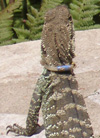![Director of National Parks [logo]](/images/dnp_90px.gif)


![Director of National Parks [logo]](/images/dnp_90px.gif) |
 |
 |
Over the years, the Water Dragons of the Australian National Botanic Gardens have been part of several scientific studies. Some recent studies at the Gardens:
Spring and Summer 2000
Nest temperatures of the Water Dragons, Physignathus lesueurii, in SouthEast Australia.
R. Meek, E. Weir and G. Sutcliffe from Huddersfield Technical College, U.K. and the Bristol University, U.K.
The nest temperatures were found to be relatively constant despite the fluctuations in external temperatures.
The nest temperatures ranged from 22oC to 32oC.
Spring 2003 – Autumn 2004
Nest Site choices compensates for climate effects on sex ratios in a lizard with environmental sex determination.
J.S. Doody et al, from the Institute for Applied Ecology, University of Canberra. More >>
Water Dragons adjusted the sex ratios of young by nesting in areas with different canopy openness.
Spring 2005 and ongoing
Water Dragon reproductive strategies
N. Pezaro and J.S. Doody from the Institute for Applied Ecology, University of Canberra.
 Water Dragon Identification: The Water Dragons are currently involved in a study on their reproductive strategies (N. Pezaro and J.S. Doody). All the Water Dragons were captured in Spring 2005 and fitted with identification collars. The researchers also determined their sex, genetics and numbers of all the Water Dragons. There are approximately 150 Water Dragons in the Botanic Gardens with 70% of the population being female. After the study is completed and the results collated, the exact numbers will be published.
Water Dragon Identification: The Water Dragons are currently involved in a study on their reproductive strategies (N. Pezaro and J.S. Doody). All the Water Dragons were captured in Spring 2005 and fitted with identification collars. The researchers also determined their sex, genetics and numbers of all the Water Dragons. There are approximately 150 Water Dragons in the Botanic Gardens with 70% of the population being female. After the study is completed and the results collated, the exact numbers will be published.
Temperature dependant sex determination: The sex of Water Dragons is not determined at conception, but after about 60% of the development of the embryos has elapsed. This period of time is known as the thermosensitive period, in which the temperature of the incubation influences which sex the Water Dragon will become. This mechanism is known as temperature dependant sex determination (TSD). In Water Dragons females are more likely to be produced at both higher and lower incubation temperatures, and males at the intermediate range.
All the nests at the Australian National Botanic Gardens were located in the 2005 breeding season and temperature loggers were placed in them to record the incubation temperatures at hourly intervals. When the hatchlings emerged in late summer to early autumn 2006, they were sexed and their paternity established by using DNA genetic markers (small tips of tail taken). In the coming spring of 2006, when the Water Dragons emerge from their winter dormancy, the collars will be removed and the Water Dragons will have micro-chips inserted into them. This will allow the study to continue, but will be less cumbersome for the Water Dragons, than wearing collars.
Questions: When the data on the temperature of incubation in the nests, the sex of the hatchlings and parents of the hatchlings is analysed it is hoped to answer the following questions:
The effects of climate change (global warming) has huge implications on those species whose sex determination is dependant on temperature. If these TSD species cannot adapt to temperature changes, then global warming is likely to skew the sex of a population and could ultimately lead to the species extinction.